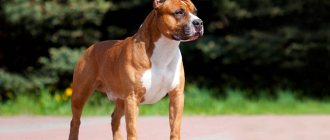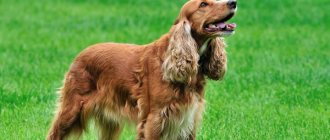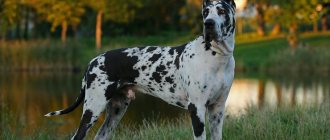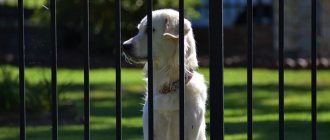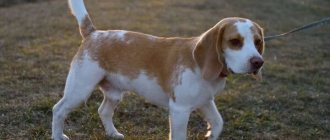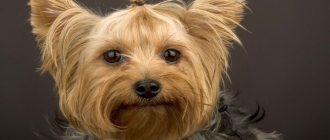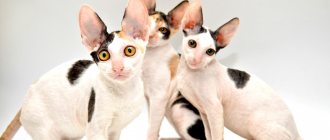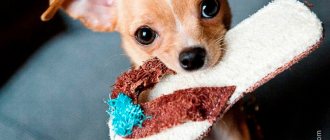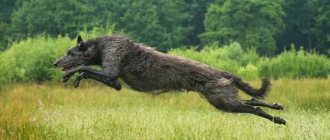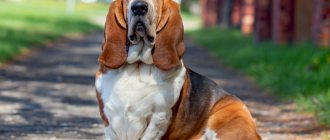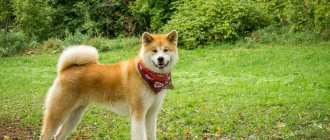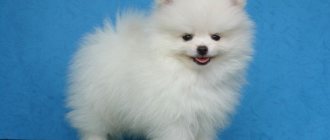Terriers are considered one of the largest groups in terms of the number of representatives among breeds. There are more than 30 varieties, which are divided into 4 main subgroups. Among them are hunting, decorative and service dogs. Different sizes of dogs allow you to choose a pet to suit your goals. Dog handlers distinguish terriers by size, coat length, and main purpose. When choosing a dog, you need to focus on the main characteristics of the breed and know the behavioral characteristics of a real hunter.
Origin story
The name of the group comes from the Latin word terra - "earth". Translated from French into Russian, the designation terrier is represented as “den, hole.” Initially, the breeds were bred by selective breeding to select the best hunting qualities for burrow hunting. The most popular trophies were foxes, badgers, and raccoons.
Some of the breeds were not subjected to selection, which made it possible to maintain authenticity and typical qualities. Among terriers there are those who have excellent watchdog qualities. Since ancient times, they have been used as guards for warehouses and storehouses.
Most terriers got their name from the area where they appeared. Known since the end of the Middle Ages, many breeds developed during the era of hunting fashion. These are several periods: from welded to gun, burrow. The gradual disappearance of wild animal prey in European forests and mountains led to a reduction in hunting breeds and the emergence of a service direction. Some breeds are on the verge of extinction. The reason for this was the world wars that took place in Europe in the 20th century. Restoration work is being carried out to revive the population of rare, endemic dogs.
As artificial selection progressed, the size decreased and adapted to the main task - searching for prey underground. It is the diversity of terriers that attracts lovers of this group. There are rare breeds that are distinguished by their sophistication and elegance. The large number is explained by the fashion for this or that dog. This does not always carry positive traits. For the sake of quantity, closely related crossings occur, which leads to the appearance of genetic defects and a decrease in natural immunity.
Protective and guard qualities
The pet’s jealous attitude towards strangers, distrust of the appearance of “new people”, and the desire to protect its pack from invasion allow the fox terrier to act as an excellent and impeccable guard. Its modest size does not mean at all that the dog is not strong and brave enough to provide adequate protection to the owner and his family.
A fox terrier dog can raise the alarm if third parties attempt to break into the house. The dog's zeal and persistence will frighten any intruder. The Fox Terrier is an excellent guard dog. Fearlessness and intelligence help the dog to be a family guard. But these qualities need to be developed in the dog if you want the fox terrier to be a guard.
Features of Terriers
All representatives of the group are characterized by common character traits:
- impulsiveness in behavior;
- ability to make decisions independently;
- mobility, activity;
- optimism, friendliness towards other pets.
Most of them require strict education combined with reasonable affection and praise. They are passionate hunters and can get carried away with the search. They tend to run away, misbehave, and destroy everything around them. This behavior is typical of a bored dog. The terrier needs constant, long walks, impressions, and training.
Almost all dogs from the “Terrier” group have special coat properties:
- Hypoallergenic, which is suitable for people suffering from various forms of allergies to animal hair and dust.
- Water-repellent ability of the cover. Dirt does not stick to it. If there is an undercoat, it does not get wet.
- There are dogs with long or smooth hair. Mostly wire-haired dogs, when trimming is required for a neat appearance. Occasionally there are breeds in which the fur curls in large curls; it feels soft and silky to the touch.
Typical hunters have a highly developed sense of smell and hearing. They are able to pursue prey with their gaze for a long time and focus on an object.
Developed muscles, a lean body, and strong limbs allow you to overcome long distances and run tirelessly. These are energetic dogs that require constant attention.
Characteristic
FCI breed number: 12,169
A harmoniously built dog is the ideal terrier. His figure should fit into a square. A cheerful and intelligent breed, dexterous and stubborn, vigilant and passionate. Anger towards prey is clearly expressed. The tough, wire-like wool helps to operate comfortably inside the burrow. Fox Terriers are distinguished between wire-haired and smooth-haired. The sexual type of these dogs is well distinguished. Males have more muscle mass and are larger and more powerful in appearance. Bitches have a more graceful physique. Constitution type – dry, lean, strong. The fox terrier's skin is elastically stretched. This breed is agile, has a very bright temperament, and at the same time, the nervous system is balanced. Distrustful and suspicious of strangers.
Height, weight, color of an adult dog
An adult dog reaches 40 cm at the withers. Bitches can be slightly lower - about 35 cm. The weight of a male varies around 8 kilograms, and that of females - about 7. Fox terriers that are too miniature are considered vicious. Also, shapeless or rough exterior features are considered a vice. Color: white, a combination of two or three colors. It can be spotted - the spots are brown, gray, black, but the dominant color is white.
Puppy weight by month
- A newborn baby fox terrier weighs 800 grams
- At 2 months he weighs 2-3 kilograms
- By 4 months the dog gains about 4 kg
- At six months of age, a fox terrier weighs up to 6 kilograms
- Adult weight reaches 10-12 months
average life expectancy
The Fox Terrier lives up to 15 years with proper care and sufficient activity throughout its life.
Allergenicity
The owners do not face any trouble in the form of allergies. The Fox Terrier does not have fluff, which is a major allergen.
What types of terriers are there?
As the number of breeds expanded, the purpose of dogs from the “terrier” group changed. Some of them began to perform official functions of protecting property, searching for people, and for rehabilitation purposes. They do an excellent job as au pairs. They bark loudly to warn of danger and are the first to attack the enemy.
Another branch is the decorative direction of selection, the production of new breeds by selection according to the requirements of society. As happened with toy terriers or Yorkies. As their popularity grows, breeds change, become smaller, and new subspecies appear. At the same time, hunting instincts, energy, and activity are preserved.
Most terriers are still used for hunting purposes. Due to their ability to move quickly, jump, and crawl into narrow spaces, the breed is used in sports competitions in the art of training.
According to the structure of the coat, they are distinguished as short, hard, long or curly. There is a selectively bred hairless breed that has a small fluff on its head and paws.
The colors range from dark to snow-white, which are difficult to see in snowy conditions.
Almost all of them have a square muzzle, thick eyebrows, and a small beard. There are those whose eyes are completely covered to protect them from dirt during burrow hunting.
By the names you can understand the nature of the origin of the dog, where it comes from. This makes it easier to navigate among the numerous hunting breeds.
All terrier breeds
Small, miniature representatives of the group
Australian Terrier
National treasure of Australia. A small dog with an inquisitive mind, attentive eyes, and keen hearing. The funny expression of the muzzle is given by long axial hair that sticks out in different directions. The character is playful, cheerful, perky. They do not tolerate competition and do not get along well with other pets.
Australian Silky Terrier
Another name for the breed is Silky Terrier. Breeding work to select qualities among many breeds has made it possible to achieve international recognition. Classified as a subgroup of the Toy Terrier. The body is decorated with long, silky fur that hangs to the floor. Partially resembles the Yorkshire Terrier in color standard. This is a brave companion that easily copes with rats, is not afraid to attack or defend.
American Hairless Terrier
The result of numerous genetic mutation experiments. This contributed to the emergence of a generation of rat terrier puppies that are almost hairless. Another variety is covered with dense hair adjacent to the body. The height is small, the body is slightly elongated, strong, muscular. The head is square in shape, the ears are large, erect, V-shaped. Temperament fearless, energetic.
American Toy Fox Terrier (Toy Terrier)
The breed is characterized by small stature. For males it is 25 cm at the withers. The body is fit, slender, the limbs are high. The body is muscular. The color is dominated by black with red tan. A tireless hunter, ready to spend the whole day searching for prey. Does not tolerate other pets.
English Toy Terrier (Manchester Toy Terrier, Black and Tan Terrier)
An endangered breed from the UK. The exterior is similar to a miniature pinscher. The character is complex, inquisitive, curious. Barks loudly, warning of danger. The color is black with red spots. The muzzle is slightly elongated, which indicates a developed sense of smell. Hearing is well developed and reacts to any rustle. Today it is a decorative companion dog for those who like to spend a lot of time outdoors.
West Highland White Terrier
A snow-white dog with short legs and an elongated body. The coat requires trimming to give it a well-groomed appearance. It is distinguished by its ability to crawl into narrow spaces, burrows, and find prey by smell. Used as a search dog. The character is lively and spontaneous. Works better in pairs with relatives.
Glen of Imaal Terrier
The dog is small in size. The legs are short, the body is elongated. The head is covered with axial bushy hair, which prevents dirt from getting into the eyes and ears. Designed for work in burrows. The enlarged sternum and powerful paws allow him to dig the ground without any problems and tirelessly tries to get a trophy.
Smooth Fox Terrier
Originally from Britain, where it was originally used for hunting foxes and badgers. Works well in pairs, notifies about prey with a loud bark, and attacks first. Wool fits tightly to the body and has water-repellent properties. The color is predominantly white, decorated with spots of brown shades.
Dandie Dinmont Terrier
The breed is considered British. He is compared to peers sitting in Parliament because he has a cap of curly hair on his head. It looks like a wig. The dog is small in size with short legs, a high tail, which is grabbed by when hunting in burrows. The coat is light, decorated with a double undercoat, which prevents heavy contamination. The temperament is complex, typical for a group of hunting dogs.
Jack Russell Terrier
Active small dog. She became famous for the film “The Mask”. It is a fashionable breed, so it has turned from a hunting breed into a decorative one. He is loved for his optimistic perception of others, boundless love for his owner and family. It is difficult to raise, but can be trained. Follows commands, runs fast, knows how to make friends with other dogs.
Wire Fox Terrier
A popular breed among burrow hunters. Wool with small curls forms a kind of “framework” that protects from wounds and dirt. A loud bark notifies about the discovery of prey. He knows how to dig holes, crawl, and catch up. He is highly intelligent and easily learns commands.
Yorkshire Terrier
The miniature dog was originally used to catch mice and rats. As selection work progressed, three subgroups appeared, differing in size. Wool requires care. Yorick cannot imagine his life without a person. They enjoy spending time together. Difficult to learn. There is a degree of nervousness and hysteria. When in danger, he barks loudly.
Cairn Terrier
The rodent hunter comes from Scotland. The owner of a thick, wire-haired coat of wheat color. It protects against adverse weather conditions. He is small in stature, so he is a nimble, active hunting assistant. Today it is a popular breed, which is gradually turning into a decorative one. Outwardly it resembles a plush toy.
German Hunting Terrier (German Jagdterrier)
The breed was bred in Germany for various types of hunting. The dog is black in color, decorated with red tan marks. The coat is hard with a sparse undercoat. It is considered a brave dog, capable of getting into a fight with an animal. The character is stubborn, persistent. Upbringing is difficult, associated with the need to break natural hardness.
Norwich Terrier
A miniature representative of brave hunters who know no fear of the beast. The body is squat, elongated. Fur of red shades with coarse hair. It forms a small mane on the sternum and neck. This protects against injury in fights with wild animals.
Norfolk Terrier (Norfolk Terrier)
A small-sized burrowing hunting breed. Wire-like wool forms a protective shell that prevents contamination and getting wet. A dog with short legs has natural courage and can attack first. Having discovered prey, it barks loudly. Loves children and is loyal to other pets.
Parson Russell Terrier
A related breed to the Jack Russell Terrier. It is distinguished by longer limbs and coat color without large spots on the body. The ears hang down to the middle of the cheekbones, the neck is strong, and the body is muscular. He runs fast and catches up.
Russian toy terrier
Bred in Russia as a hunting and decorative dog. The ears stand high, the body is graceful, the nose is narrow, the eyes are lively. Due to its miniature size, it can fit into narrow cracks and spaces. The coat is smooth and dense. When in danger, he barks loudly. There is no aggression in behavior; an obedient dog is used today as a decorative breed.
Sealyham Terrier
Rich, long white fur hangs almost to the ground. On her head she covers her eyes, which protects her from dirt. Used exclusively for burrow hunting. Due to its strong muscles, it covers long distances and digs in well. When trained, it shows instinctive stubbornness.
Skye Terrier
Scottish breed for hunting small game. The coat is long, covering the entire body and muzzle. Ears are straight or drooping. The character is active, cheerful. Due to their narrow body and strong paws, they easily penetrate the burrows of wild animals.
Scotch Terrier (Scottish Terrier)
A squat hunting breed bred for burrowing to catch small wild animals. Possesses intelligence and obedience. With courage he rushes to defend himself from the enemy. Treats other dogs favorably. The head is square, the ears are V-shaped and set high. There is a beard on the face, which gives the dog a funny look.
Czech Terrier (Bohemian Terrier)
At first glance, the dog looks like a small toy, it is so small. The black coat with center hairs emphasizes its terrier identity. A small beard grows on the lower jaw, and the brow ridges are decorated with eyebrows. It barks loudly and knows how to quickly find prey. An elongated body imparts agility and agility.
Average representatives
American Pit Bull Terrier
The breed was created by crossing terriers and bulldogs. Previously used as a participant in dog fighting. After their ban, it was used to catch rats and small rodents. The character is complex, the disposition is active. The coat is dense, the tail is raised high, the body is taut. The sternum is well developed. Due to its powerful limbs, it runs quickly and reacts instantly to stimuli. Average height, heavy weight. Feels powerful and strong. Causes fear in others.
American Staffordshire Terrier
The body is muscular, powerful, strong. The grip is tight, the reaction is instant. A real killer dog that fearlessly rushes into battle with any enemy. The height at the withers is no more than 50 cm in males. Dense fur adheres to the body, the skin has the ability to stretch greatly, which saves from injury. To raise an obedient puppy, you will have to put in a lot of effort and show a strong character.
Bedlington Terrier (Rothbury Terrier)
The graceful dog looks like a small sheep. The specific wedge-shaped structure of the muzzle distinguishes it from other representatives of the group. The stomach is tucked, the limbs are elongated. The coat color is exclusively white, the hair structure is curly. There are small tassels on the ears, which gives a funny look. They hunt rats, catch mice, and like to run a lot.
Border Terrier
A breed born on the border of Scotland and Britain. Intended for hunting small rodents. Medium size dog, square parameters. The coat is hard, decorated with axial hairs. Most of them are concentrated on the beard, eyebrows, cheeks. Temperament is very active and lively. Loves to hunt, track, catch up.
Boston Terrier
The cute-looking dog is the result of crossing a bulldog with an English terrier. Country of origin: USA, where it is popular. The body is closer to square, the limbs are widely spaced, the sternum is powerful, the stomach is tucked. The neck is short and powerful. A strong, small-sized dog that enjoys being close to humans.
Brazilian Terrier
Bred at the beginning of the twentieth century for hunting rats, rodents, and small animals. Medium height, short white fur, decorated with large dark spots. There is a mask on the head, the ears are slightly drooping in the shape of the letter V. The gaze is lively, interested in everything that is happening around. Used in guard duty, as a companion for the owner.
Bull Terrier
A short-haired breed with a specific muzzle that is difficult not to recognize. The straight bridge of the nose does not form a hollow between the nose and immediately passes to the frontal bone. The eyes are located on the sides. The appearance is terrifying. It is considered an ideal rat catcher and fighting dog. The character is complex.
Welsh Terrier
Medium sized dog. The exterior is similar to the Airedale Terrier. Hunting instincts are clearly expressed. Character restless, nervous. Reacts to any rustle. It's hard to raise. Needs a strong owner who can cope with the dog's temperament.
Irish Terrier
The breed has an unusual appearance. The coat color is bright red. The muzzle is decorated with a beard, eyebrows made of medium-sized axial hairs, forming brushes. Height up to 50 cm at the withers. Fighting ones are capable of being difficult to tame. The dog is constantly ready to find prey and engage in an unequal fight. Nimbleness, activity, stubbornness are the natural traits of the “Irish”.
Kerry Blue Terrier
A medium sized breed with a typical appearance. A beard forms on the lower jaw, and thick eyebrows appear above the eyes. An ideal dog for allergy sufferers. Originates from County Kerry (Great Britain), where it is used for hunting, as a watchman, and as a shepherd. The color of the coat is dark silver. With proper training, the result is an easy-going dog that flawlessly follows commands.
Lakeland Terrier (Patterdale Terrier, Lake District Terrier)
A fearless dog with a cheerful disposition that is designed to protect livestock areas from wild animals. A hunting breed that has a group-specific appearance. The ears hang down, the fur covers the eyes. The muzzle is square, the tail is set high. An ideal dog for mountainous areas.
Manchester Terrier
A smooth-haired hunting dog, named after the area where selection was first carried out. A tall black dog with tan marks on his chest, paws, and belly. The muzzle is narrow, which indicates an excellent sense of smell. The ears are V-shaped, hanging, and have an attentive gaze. Considered to be the oldest hunting breed for working in a group.
Patterdale Terrier
An athletically developed black dog. Coarse fur adorns the eyebrows, lips, and lower jaw. The ears are hanging, pressed to the skull. The body is lean. On the limbs and body the fur is smooth and lies tightly to the body. A passionate hunter, ready to constantly search and pursue prey. An ideal breed for burrow hunting of medium-sized animals living in burrows. Favorite of England, USA. Not recognized by the International Canine Association.
Wheaten Terrier
Curly, soft coat is the main characteristic of this breed. The lack of undercoat makes it a little vulnerable to bad weather conditions. A passionate hunter with a good-natured character, he is valued for his ability to spot prey. Average height, well-developed muscles allow you to quickly catch up and pursue the animal for a long time. Gets along well in the house, there is no natural aggression towards household members.
Staffordshire Bull Terrier
The dog was bred artificially by crossing an English terrier with a bulldog. The result was a medium-sized dog with clearly strong bones and strong muscle mass. The initial impression is one of fear and respect. Initially suitable for baiting rats. Now it is a companion dog, in which service characteristics dominate. Shows aggressive behavior, so strict education is necessary. He cannot imagine himself outside of his family, to whom he is endlessly devoted.
Tibetan Terrier
Tibetan herding aboriginal breed that has not been subjected to selection. Progenitor of the Shih Tzu. Classified as a terrier due to its external similarity. Medium sized dog. Head, body square. The bangs cover the eyes, hanging from the forehead. An obedient dog with whom there is never a dull moment. An excellent guard, for whom it is important to be close to the owner.
Japanese Terrier
The fox terrier became the basis for selection, which led to the appearance of the breed in the Land of the Rising Sun. Used for hunting small game. The wool is smooth and does not allow dirt to stick. Valued for its ability to instantly detect a trophy in a hole and pursue it by scent. For the Japanese, this is an unusual breed, which is similar in character to the Akita or Shibu Inu.
Large breeds
Uruguayan Cimarron Terrier (Uruguayan Wild Dog, Cimarron)
South American smooth-haired breed. Bred for the purpose of protecting livestock, housing, territory, and hunting large animals. The impressive size seems intimidating. The thick skin can stretch, which protects against wounds. The body is massive, the limbs are strong. Physical endurance and power allows you to overcome distances and attack enemies.
Black Terrier (Russian Black Terrier)
Brought out in the USSR by crossing different working breeds. The result was a universal dog for guarding and hunting. He is tall, reaching 70 cm at the withers. Externally, the dog is similar to a Giant Schnauzer, but more powerful in the torso. Not recognized internationally. “Stalin’s Dog” can be trusted to protect the family and territory. Has a developed sense of smell and sensitive hearing. The coat color is exclusively black.
Airedale
As selection progressed, the dog's hunting properties gradually disappeared. The breed is used as a service breed to search for prohibited substances, guard, and protect. He is tall and has well-developed muscles. It is distinguished by obedience and the ability to understand the intonations of the owner’s voice. Balanced character. She became popular in the USSR after filming the film “The Adventures of Electronics”.
Spaniel hunting dogs
The birthplace of spaniels is Spain. They were bred specifically for catching birds. Later, two groups of spaniels were formed, one of which was intended for hunting birds in the fields, and the other was trained to catch birds on the water.
These dogs have a flexible mind and excellent sense of smell, and are easy to train. They can perfectly replace a pointing dog on a hunt. There are several types of small-sized spaniels that belong to the group of gun dogs that help hunters search for and bring downed game.
Russian hunting spaniel
The Russian spaniel has a height of 36 to 44 cm and is distinguished by its elongated physique, light head with ears located at eye level and shorter than those of other spaniel breeds. Their coat is characterized by moderate length and thickness. Spaniels belonging to this species are obedient, clean, sweet and cheerful dogs.
The dog of this type of spaniel has a keen sense of smell and hearing. One of her best qualities is her good intuition in finding prey. She is an indispensable assistant in catching wild goats, hares and dray. During the hunt, it is distinguished by endurance and clearly follows the owner’s commands.
English cocker spaniel
This breed has a compact body with a well-developed chest and strong paws. The dogs grow from 38 to 40.5 cm and weigh from 13 to 15.5 kg. The main difference between the “Englishman” is the low-set, thin and long ears, covered with silky hair, giving the dog a unique charm. The body is covered with long and silky hair. The color can be solid - black, red or brown, possibly with a white chest; two-color - piebald with black, red or brown spots or tri-color - black and white tan.
The character of this dog is characterized by perseverance, endurance and devotion to the owner. Her excellent sense of smell and persistence in searching for prey are irreplaceable qualities when hunting. English Cocker Spaniels are lively and cheerful dogs who love to express their mood with loud barks. They always try to please their owner, can be obedient and are capable of learning.
American Cocker Spaniel
The American Spaniel is more compact in build than its English counterpart. It grows from 34 to 39 cm and weighs from 10 to 13 kg. The main feature of these dogs is their dome-shaped head with distinct brow ridges. The low-set ears are covered with long and thick hair, like the rest of the dog's body. It is similar in color to the English Cocker Spaniel and can be single-colored, two-colored, or tri-colored.
Possessing great abilities and active behavior, this species easily and quickly learns the commands and skills of hunting small furry animals and birds. American Cocker Spaniels are very inquisitive, love to play with children and get along well with other pets.
King Charles Spaniel
This type of spaniel was bred by English aristocrats to hunt small animals and birds. These are small, cute dogs measuring from 25 to 29 cm at the withers and weighing 5-7 kg with a funny flattened muzzle, bulging button eyes, floppy ears and short limbs. Their coat comes in four types: white with black spots and tan, white and red, bright red and black with tan.
King Charles Spaniels are very intelligent and easy-going dogs with a playful nature. They love to please their owner, but can sometimes show their independence.
Tibetan Spaniel
Tibetan spaniels are small in stature, reaching 24-27 cm at the withers. The dog is distinguished by a short neck, giving the impression that the head is attached to its body. She has a small muzzle, with dark brown eyes framed by black eyelids expressing surprise and beautiful drooping ears.
Sweet appearance is the complete opposite of character: persistent, persistent, courageous and energetic. After being brought to Europe, Tibetan spaniels have proven themselves to be skilled bird hunters.
How to choose the best puppy
If you decide to get a terrier, then first you need to pay attention to the size. A wide range of hunting dogs allows you to choose from a small dog or a large dog. The ideal dog for an apartment would be one that does not take up much space. For a country house, choose a corpulent pet.
To avoid problems with health and education, you need to know a few points:
- buy only from trusted breeders who have been breeding the breed for a long time;
- when choosing a puppy from a litter, pay attention to active behavior, absence of visible signs of disease (tearing eyes, discharge, cleanliness of coat);
- by nature, terriers are overly dynamic, showing interest in everything that moves, so monitor their behavior in the enclosure or cage;
- ask the puppy owners for documents, including veterinary vaccination certificates and parent pedigrees;
- Find out the peculiarities of living in an apartment, house, approaches to feeding, possible problems.
An experienced dog handler will be happy to tell you about the advantages of the breed and its characteristics. If you notice that the breeder is haggling, lowering the price, then this is a reason to think about it. There are not always honest sellers who sell healthy puppies.
To confirm the health of the dog, you need to make sure that you have a veterinary passport and registration in a canine monobreed association. It is important to avoid the results of inbreeding, which leads to the manifestation of genetic diseases (pelvic dysplasia, problems with vision and the digestive tract, infertility).
Content
Care
Caring for a Fox Terrier is very simple. Every month you should check your dog's ears. But if they are clean and healthy, then you can limit yourself to inspection. The ears are given more attention as the weak point of this breed. They even pluck out coarse hairs so that they do not cause discomfort to the dog. The ears are cleaned with a cotton swab and sprinkled with baby powder.
The Fox Terrier is prone to gum disease, so you need to give him solid food more often, chewing which will also remove plaque from his teeth. These can be crackers, raw carrots and more.
You should check your dog's paw pads regularly. Your dog's nails should be trimmed every week.
In winter, after a walk and washing the paws, the pads on the paws can be lubricated with fat, this will protect them from drying out and painful cracks.
Daily walks with training for the dog. The dog can run next to the owner and his bicycle, run after a ball or a stick. The Fox Terrier needs physical activity like air.
Bathing your dog is not necessary. If the dog gets dirty and needs to be washed, it is better to use the shower. Don't shower too hot or cold. The ideal option is water at about the dog’s body temperature.
Trimming is done once every six months.
Nutrition
Fox Terriers do not require special nutrition. Whether you feed your pet ready-made food or prepare it yourself: the main thing is that the food is rich in nutrients. If the dog’s fur has stopped shining, this may serve as a signal about the beginning of problems in the dog’s well-being.
Advantages and disadvantages
Any breed from the terrier group can have its positive and negative sides. The following characteristics are recognized among the advantages:
- instinctively developed hunting sense, passion, hearing;
- wool does not cause allergies in many representatives;
- suitable for those who cannot imagine their life without activity;
- they love to run, jump, and exercise a lot;
- There is a wide choice based on size, preferred character, coat color.
With proper strict upbringing, a terrier dog is obedient and treats others without aggression. She will listen carefully to her owner and follow commands. It is considered ideal to have a “hunting mate.” By nature, they are used to being together and working in a pack. There are many negative aspects that stop you from buying puppies from the terrier group:
- Overly dynamic behavior that is difficult to correct.
- A dog on the street behaves restlessly, constantly “taking the scent”, “looking for prey”.
- During a walk, the dog can become distracted and run away. Special training is required to develop obedience skills.
- The character contains a share of aggressive attitude towards small children, pets, and other dogs. This is natural behavior for hunting breeds. You need to be careful if there are small rodents or other animals at home.
- Excessive affection or severity will lead to the formation of a neurotic character, spoiledness. The owner's attitude should be calm and measured. Then the dog will feel protected. This is especially true for miniature, decorative dogs, which by nature are ready to stand up for themselves, displaying aggressive behavior.
Dogs from the terrier group can become reliable friends, true companions. There's never a dull moment with them. Patience, moderate affection, reasonable punishments will help raise a reliable friend.
Character
The dog is extremely active and very mobile. The Fox Terrier does nothing, perhaps only when he sleeps. The rest of the time he is constantly busy with “his own business.” This breed is absolutely not suitable for people who are accustomed to leading an inactive lifestyle, sedentary people, and elderly people. Both at home and on the street, the Fox Terrier is very active. Perseverance is not their trait. This dog will never just sit or lie around like that. For a private house, a fox terrier is more preferable than for an apartment. But if the owners can provide their pet with regular walking, then these conditions are quite suitable.
By its nature, the Fox Terrier tends to dominate. For this reason, the owner must be strict and firm. Physical force should not be used as punishment on this pet because it may result in aggression in response.
The Fox Terrier's affection for its owner is limitless. But in return, the dog will give unconditional love and loyalty. The Fox Terrier gets along very well with children. They get along well with the rest of the four-legged members of the “pack”, that is, the family. But it is certainly better to adopt a fox terrier as a puppy. An adult dog may not accept other adult animals, which can lead to trouble in the form of constant chasing after them.
He is friendly towards other Foxes and does not show aggression. But in case of a threat from them, it will defend its owner and members of its family. Fox Terriers love admiration for his person. Therefore, this may be the main reward lever for this dog.
Similar breeds
Most representatives of the “Terrier” group are similar in habits to dachshunds. The same burrow hunting, agility, loud barking - something that is akin to hunters of foxes, raccoons, and badgers.
They were bred to extract trophies from the ground, but they can follow a blood trail for a long time, catch up, drive. This is similar to pointing breeds.
Large and medium-sized breeds can become service dogs that help in searching and detecting dangerous substances. Some of them are faithful assistants for the rehabilitation of patients. They serve in the police, army, and customs.
In character, some pets are similar to Labradors in their devotion, sincerity, love for family and owner. It is important for them to always be nearby, despite the desire to rush off to play with other dogs. They appreciate care and attention. For their friends, these are very affectionate dogs.
Average representatives of the terrier breeds easily cope with the tasks of guarding and herding livestock. In this they are similar to shepherds, who skillfully herd the herd, protect the flock from attack in time, and do not let strangers in. Therefore they are suitable for agricultural breeds.
By their nature, shorthaired terriers are similar to Molossians. They are distinguished by calmness and leisurely behavior as long as there is no potential victim nearby. This also includes a harsh, brutal exterior that can frighten with its appearance.
Basset Hound
The Basset Hound is a breed of hound hunting dog that was bred specifically for foot hunting and was used in hunting foxes and badgers. Possessing a unique sense of smell, they track prey, tirelessly pursue it, but do not attack, leaving it to the hunter to set the final point in catching the animal.
Appearance of the breed
Description:
- The long body of the Basset Hound is covered with abundantly hanging skin. It is strong, muscular and has short legs. The tail of dogs is long and raised in the shape of a saber. With a small height of 33 to 38 cm, these dogs are very heavy. Their weight ranges from 22 to 27 kg.
- The head and neck of the Basset Hound are covered with wrinkles, giving the face a sad expression. The muzzle and nose of this breed are long, which allows them to keep them close to the ground and sniff out the animal. The portrait of the dog is completed with drooping ears.
- The Basset Hound is a short-haired breed with a smooth coat, the color of which is tri-colored with spots of varying location and shape.
Character and behavior
For a hound dog, their personality is quite gentle and calm. Basset Hounds are friendly and rarely show aggression. They get along well with other dogs, as they are used to hunting in a pack. Thanks to endurance and endurance, they can follow the trail of an animal for several hours.
They are easy to learn the skills of tracking and pursuing prey, but difficult to train, due to their stubborn nature. This breed of dog loves to bark loudly, and if during the hunt they bark to warn about the beast, then in the apartment this creates inconvenience.
Reviews
Yulia, 44 years old I have loved Airedale terriers since childhood. I became an adult and bought my first puppy, Charlie. The character turned out to be complex. He had a lot of conflicts, ran away, and didn’t listen. I had to turn to dog handlers; I couldn’t have done it alone. Following Charlik, I acquired another one. Terry has been there for 5 years and has had no problems. I would call him a little lazy. Dogs are very different. It is difficult to say that this is a hunting breed. More like a service one. My real assistants in protecting the dacha and home.
Peter, 28 years old My Asterlix is a West Highland White Terrier. Everyone affectionately calls them “Vestiki”. A wonderful dog who is ready to walk in the park for hours. The only drawback is that it constantly “sniffs” and picks up everything from the ground. As soon as I didn’t wean myself off it. Does not work. He goes with me everywhere, loves the car, and is crazy about trips to the river. You have to wash it constantly, because white wool and the city do not mix well. Otherwise, a wonderful friend who will happily sit with you in front of the TV, watch a sports match, and will simply always be there. I love it.
Alexandra Petrovna, 62 years old The doctor advised me to constantly walk after the operation. She would never leave the house on her own, but with a dog it’s a different matter. For their 60th birthday, the children gave them a tiny Yorkshire terrier puppy. I immediately fell in love. Marta is a sincere, devoted dog. We are with her everywhere. It's nice to pamper her, buy her treats, dress her in different ways. She is a calm, balanced lady, but as soon as she sees a big dog, she gets wildly hysterical. It is clear that this is out of fear. It looks funny, there were many comical situations. If it weren’t for Martochka, I would still be lying on the sofa, watching TV. Now I have a schedule, we walk around our area as a group. New friends have appeared who are passionate about dog breeding.
Love, 45 years old One day my husband brought a puppy. I was categorically against having a dog in the house, and besides, one of the children has a severe allergy to wool. It turned out to be a Kerry Blue Terrier. According to the assurances of the spouse, the child will not have problems. The puppy was growing, and I kept my medications at the ready, I was still afraid that an asthma attack would begin. Myron is already 5 years old. All this time I did not believe that there would be no problems. The husband and children are taking care of the dog. The new doctor who appeared at our site confirmed that my fears were in vain. I didn't even know there were hypoallergenic dogs. Everyone loves the dog for his cheerful disposition.
Semyon, 38 years old I saw burrow hunting on TV and was inspired to take up it. I really liked the idea that you could catch an animal without shooting. Friends advised me to adopt a burrow terrier. I spent a long time choosing between a dachshund and a smooth fox terrier. And then a friend of mine has a new litter. He took a friend and named him Hunter, which means hunter. You have no idea how smart and loyal this dog is! He and I not only mastered the commands, but also regularly participate in competitions and go to exhibitions. For me this is a real outlet. My dream of catching an animal without a weapon came true. Hunter is a tenacious dog with a strong character, he is just a copy of me.
Learning ability
Fox is a dog for hunters, so those who are far from this activity are not recommended to have this particular breed. The basis for raising a dog should be not just sufficient activity, but the opportunity to realize its hunting inclinations. A small fox terrier begins to be trained from its first day in the house. One of the first tasks is toilet training. To do this, you need to walk with a leash and accustom him to a collar as early as possible.
The dog is quite trainable (4 out of 5 points), but you need to start working with it from childhood. At first these may be short 20-minute sessions, which will become longer over time. Then you can move on to an artificial hole.
Enjoys learning new commands and tricks. The Fox Terrier is agile, jumping, as if on springs, so the tricks it performs look very fun. It is not for nothing that this breed has been involved in filming more than once.
Recommendation: classes should be carried out on an empty stomach, then the dog is more obedient and shows more interest.
Briefly about the main thing
- The terrier group is the largest in terms of the number of breed representatives.
- They can be large, medium or small in size.
- Wool has hypoallergenic properties, protects against bad weather conditions, and has a hydrophobic characteristic. It does not get wet, dirt and dust do not stick to it. When dry, it shakes off quickly.
- Depending on the breed, each dog has its own purpose. Some are used exclusively for hunting small and medium-sized wild animals. Some of them are suitable as decorative dogs, accompanying the owner everywhere.
- All terriers require additional coat care. Most often, trimming and special combing are necessary to give the most advantageous look. If you don’t do this, the wool falls off and becomes like felt boots. It is important to care for your dog from early childhood and teach it how to care for it.
- Some breeds are bred through selection, which means the smoothing out of negative behavioral traits and the emergence of new positive characteristics.
- Most terriers have a restless, complex character. Behavior during a walk is sharply distinguished by its activity, dynamism, and disobedience. In any case, you will have to show will, firmness, and perseverance in order to overcome your natural instincts to search and discover prey.
- Terriers do not tolerate loneliness. If they are bored, they are ready to destroy everything around them and entertain them in different ways. They feel great in a pair and relate well to their relatives.
- A rare dog will tolerate being in the same neighborhood as other pets (hamsters, minks, rats, cats). For him, this is potential prey of natural interest. We must be very careful not to leave them alone with each other.
- When choosing a puppy, you need to decide on the size of the breed and its main characteristics. You cannot buy a puppy from your own hands, without a veterinary examination and documents.
- It is important for hunting breeds to exercise their natural instincts. Walks should be long and active. Dogs are suitable for those who lead a healthy lifestyle, love to travel, and play sports.
Fox terrier
The Fox Terrier is a type of fox burrow dog bred in the late 18th century to kill rats. Over the centuries, the fox terrier has become man's faithful assistant in hunting foxes, badgers and raccoons.
Possessing an amazing scent, strength and quick reaction, he is always ready to fight the beast.
Appearance
Description:
- The body of the Fox Terrier is compact, proportional, similar to a slightly elongated rectangle, located on small paws. The breed is characterized by a short, straight back, deep chest and graceful neck that widens towards the shoulders. The height of dogs, depending on their gender, is from 33 to 41 cm, and their weight is from 6.8 to 7.7 kg.
- The head is of medium width with a flat forehead, tapering towards the eyes. The dog's muzzle is almost rectangular with a rounded end. It is distinguished by a black nose and round, deep-set eyes of a dark brown color, expressing alertness, interest and cheerfulness. The ears are of medium size with a break above the forehead directed towards the cheekbones.
- Fox Terriers are either smooth-haired or wire-haired. Wire-haired dogs have slightly shorter hair on their face and paws than on their body. The color of dogs is tricolor - white with spots of brown and black, and bicolor - with red spots on a white background.
Character
Fox Terriers are endowed with a lively and restless temperament. Distinctive features of their character are intelligence, activity and cheerfulness.
They are friendly towards humans, love to play with children and are ready to throw themselves into fire and water for their owner. They show anger, vigilance and courage towards the beast, being wonderful hunting companions.
